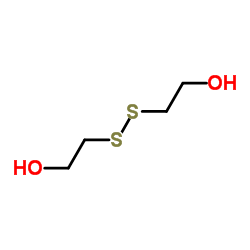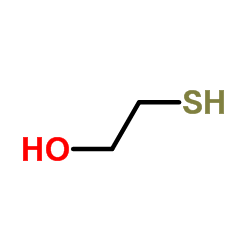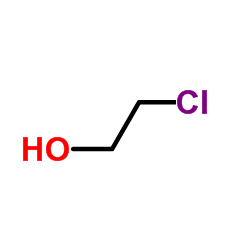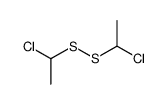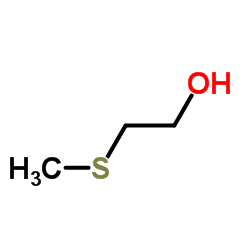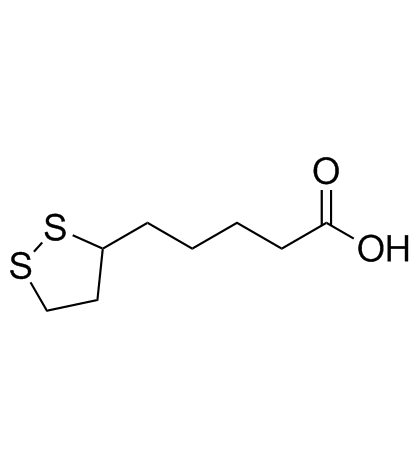1892-29-1
| Name | 2,2'-dithiodiethanol |
|---|---|
| Synonyms |
2,2'-DINAPHTHYL KETONE
MFCD00002906 ETHANOL,2,2'-DITHIODI EINECS 217-576-6 2-hydroxyethyl disulphide 2-Hydroxyethanedisulfide Diethanol disulfide Hydroxyethyl disulfide 2-Hydroxyethyl disulfide 2-(2-hydroxyethyldisulfanyl)ethanol bishydroxyethyldisulfide Dithiodiglycol 2,2'-Dithiodiethanol Ethanol,2,2'-dithiobis |
| Density | 1.3±0.1 g/cm3 |
|---|---|
| Boiling Point | 306.5±27.0 °C at 760 mmHg |
| Melting Point | 25-27 °C(lit.) |
| Molecular Formula | C4H10O2S2 |
| Molecular Weight | 154.251 |
| Flash Point | 149.3±22.4 °C |
| Exact Mass | 154.012222 |
| PSA | 91.06000 |
| LogP | 0.51 |
| Vapour Pressure | 0.0±1.5 mmHg at 25°C |
| Index of Refraction | 1.590 |
Synonym:2,2'-Dithiodiethano Section 2 - COMPOSITION, INFORMATION ON INGREDIENTS
Risk Phrases: 23/24/25 41 Section 3 - HAZARDS IDENTIFICATION EMERGENCY OVERVIEW
Toxic by inhalation, in contact with skin and if swallowed. Risk of serious damage to eyes.The toxicological properties of this material have not been fully investigated. Potential Health Effects Eye: May cause eye irritation. Risk of serious damage to eyes. Skin: May cause skin irritation. Toxic in contact with skin. Ingestion: May cause irritation of the digestive tract. The toxicological properties of this substance have not been fully investigated. Toxic if swallowed. Inhalation: May cause respiratory tract irritation. The toxicological properties of this substance have not been fully investigated. Toxic if inhaled. Chronic: No information found. Section 4 - FIRST AID MEASURES Eyes: Immediately flush eyes with plenty of water for at least 15 minutes, occasionally lifting the upper and lower eyelids. Get medical aid immediately. Skin: Get medical aid immediately. Immediately flush skin with plenty of water for at least 15 minutes while removing contaminated clothing and shoes. Ingestion: Wash mouth out with water. If swallowed, do not induce vomiting unless directed to do so by medical personnel. Never give anything by mouth to an unconscious person. Get medical aid. Inhalation: Get medical aid immediately. Remove from exposure and move to fresh air immediately. If not breathing, give artificial respiration. If breathing is difficult, give oxygen. Notes to Physician: Treat symptomatically and supportively. Section 5 - FIRE FIGHTING MEASURES General Information: As in any fire, wear a self-contained breathing apparatus in pressure-demand, MSHA/NIOSH (approved or equivalent), and full protective gear. During a fire, irritating and highly toxic gases may be generated by thermal decomposition or combustion. Extinguishing Media: Use water spray, dry chemical, carbon dioxide, or chemical foam. Section 6 - ACCIDENTAL RELEASE MEASURES General Information: Use proper personal protective equipment as indicated in Section 8. Spills/Leaks: Absorb spill with inert material (e.g. vermiculite, sand or earth), then place in suitable container. Clean up spills immediately, observing precautions in the Protective Equipment section. Sweep up or absorb material, then place into a suitable clean, dry, closed container for disposal. Avoid generating dusty conditions. Provide ventilation. Section 7 - HANDLING and STORAGE Handling: Wash thoroughly after handling. Do not breathe dust, vapor, mist, or gas. Do not get in eyes, on skin, or on clothing. Keep container tightly closed. Do not ingest or inhale. Use only in a chemical fume hood. Storage: Store in a cool, dry place. Store in a tightly closed container. Section 8 - EXPOSURE CONTROLS, PERSONAL PROTECTION Engineering Controls: Facilities storing or utilizing this material should be equipped with an eyewash facility and a safety shower. Use adequate ventilation to keep airborne concentrations low. Exposure Limits CAS# 1892-29-1: Personal Protective Equipment Eyes: Wear appropriate protective eyeglasses or chemical safety goggles as described by OSHA's eye and face protection regulations in 29 CFR 1910.133 or European Standard EN166. Skin: Wear appropriate protective gloves to prevent skin exposure. Clothing: Wear appropriate protective clothing to prevent skin exposure. Respirators: Follow the OSHA respirator regulations found in 29 CFR 1910.134 or European Standard EN 149. Use a NIOSH/MSHA or European Standard EN 149 approved respirator if exposure limits are exceeded or if irritation or other symptoms are experienced. Section 9 - PHYSICAL AND CHEMICAL PROPERTIES Physical State: Solid or liquid Color: after melting, clear yellow Odor: stench pH: Not available. Vapor Pressure: Not available. Viscosity: Not available. Boiling Point: 158 - 163 deg C @3.5mmHg Freezing/Melting Point: 25 - 27 deg C Autoignition Temperature: Not available. Flash Point: > 110 deg C (> 230.00 deg F) Explosion Limits, lower: Not available. Explosion Limits, upper: Not available. Decomposition Temperature: Solubility in water: Soluble. Specific Gravity/Density: 1.288 Molecular Formula: C4H10O2S2 Molecular Weight: 154.25 Section 10 - STABILITY AND REACTIVITY Chemical Stability: Stable. Conditions to Avoid: Excess heat. Incompatibilities with Other Materials: Strong oxidizing agents, acid chlorides, acid anhydrides. Hazardous Decomposition Products: Carbon monoxide, oxides of sulfur, carbon dioxide. Hazardous Polymerization: Will not occur. Section 11 - TOXICOLOGICAL INFORMATION RTECS#: CAS# 1892-29-1: KK7525000 LD50/LC50: CAS# 1892-29-1: Oral, rat: LD50 = 173 mg/kg. Carcinogenicity: 2-Hydroxyethyl disulfide, tech. - Not listed by ACGIH, IARC, or NTP. Other: See actual entry in RTECS for complete information. Section 12 - ECOLOGICAL INFORMATION Section 13 - DISPOSAL CONSIDERATIONS Dispose of in a manner consistent with federal, state, and local regulations. Section 14 - TRANSPORT INFORMATION IATA Shipping Name: TOXIC SOLIDS, ORGANIC, N.O.S. Hazard Class: 6.1 UN Number: 2811 Packing Group: III IMO Shipping Name: TOXIC SOLIDS, ORGANIC, N.O.S. Hazard Class: 6.1 UN Number: 2811 Packing Group: III RID/ADR Shipping Name: TOXIC SOLIDS, ORGANIC, N.O.S. Hazard Class: 6.1 UN Number: 2811 Packing group: III Section 15 - REGULATORY INFORMATION European/International Regulations European Labeling in Accordance with EC Directives Hazard Symbols: T Risk Phrases: R 23/24/25 Toxic by inhalation, in contact with skin and if swallowed. R 41 Risk of serious damage to eyes. Safety Phrases: S 26 In case of contact with eyes, rinse immediately with plenty of water and seek medical advice. S 28A After contact with skin, wash immediately with plenty of water. S 36/37/39 Wear suitable protective clothing, gloves and eye/face protection. S 38 In case of insufficient ventilation, wear suitable respiratory equipment. S 45 In case of accident or if you feel unwell, seek medical advice immediately (show the label where possible). WGK (Water Danger/Protection) CAS# 1892-29-1: No information available. Canada CAS# 1892-29-1 is listed on Canada's NDSL List. CAS# 1892-29-1 is not listed on Canada's Ingredient Disclosure List. US FEDERAL TSCA CAS# 1892-29-1 is listed on the TSCA inventory. SECTION 16 - ADDITIONAL INFORMATION N/A |
CHEMICAL IDENTIFICATION
HEALTH HAZARD DATAACUTE TOXICITY DATA
|
| Symbol |


GHS05, GHS06 |
|---|---|
| Signal Word | Danger |
| Hazard Statements | H301-H318 |
| Precautionary Statements | P280-P301 + P310-P305 + P351 + P338 |
| Personal Protective Equipment | Eyeshields;Faceshields;full-face respirator (US);Gloves;multi-purpose combination respirator cartridge (US);type ABEK (EN14387) respirator filter |
| Hazard Codes | T:Toxic; |
| Risk Phrases | R23/24/25 |
| Safety Phrases | S26-S39-S45 |
| RIDADR | UN 2811 6.1/PG 3 |
| WGK Germany | 3 |
| RTECS | KK7525000 |
| Packaging Group | III |
| Hazard Class | 6.1 |
| HS Code | 2930909090 |
| Precursor 9 | |
|---|---|
| DownStream 9 | |
| HS Code | 2930909090 |
|---|---|
| Summary | 2930909090. other organo-sulphur compounds. VAT:17.0%. Tax rebate rate:13.0%. . MFN tariff:6.5%. General tariff:30.0% |
